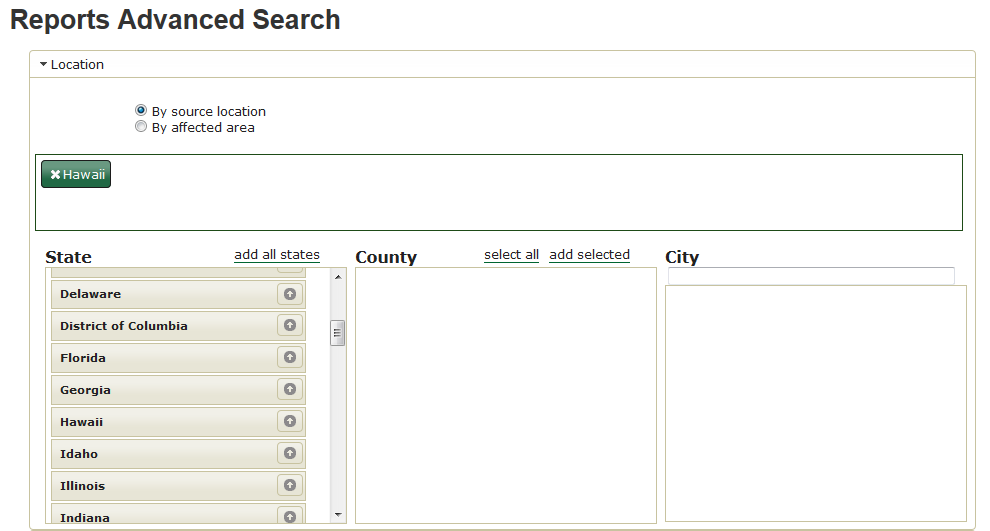We incorporate reports from many sources, so our database is set up to accommodate
several different types of reports. Each report type has an icon to make it more
visually distinct. The legend allows users to choose whether they wish to see reports
from all sources, or only from selected sources. The report type icons below the
map show which report types were included in the search.
Media reports
We use a daily electronic media search – the equivalent of what used to be called
a clipping service – to scan thousands of U.S. media outlets for drought-related
news stories. Our moderator logs the relevant clippings as media reports. Because
of the sheer volume of news stories and the dedicated effort
of the moderator, most reports in the Drought Impact Reporter are from media. The
NDMC stores but does not publish the full text of media reports, in order to comply
with copyright law.
Hawaii Reports
Anyone can submit a Hawaii report. You can get to the Submit a Report form via
the main navigation bar above the map at http://hawaii.droughtreporter.unl.edu.
More detailed instructions are available on the form. Note that user reports are
moderated, so it may take a business day or two for them to show up.
Although the form allows users to submit a link to more information such as a news
story, we especially value original observations or information. We have a separate
process for media reports.
If you are reporting on your own experience of drought, it is OK to write in first-person
– to say “I,” “me” and “us.”
Hawaii Reports are the same as User Reports, below, but with agricultural
sub-categories tailored to Hawaii's needs.
The best way to see what losses have been reported in the agricultural
sub-categories is by accessing the Advanced Search > Reports page from the
navigation bar, selecting Hawaii as the location, and unselecting all the Source
Types except for Hawaii Reports.


Dollar values associated with any of the agricultural sub-categories are shown as a total for Agriculture and are also shown as losses within the sub-categories. It would be a mistake to add the value next to Agriculture to the values next to the sub-categories.
Here is an example of a user report with impact information:
Other reports contain valuable information that may indicate that an impact will
occur soon.These reports are visible on the reports layer of the map, but
not on the impacts layer.
Here is an example of a report with useful information about drought conditions
that doesn’t meet our definition of an impact, because the impact hasn’t
occurred yet.
User Reports
Anyone can submit a user report. You can get to the Submit a Report form via the
main navigation bar above the map. More detailed instructions are available on the
form. Note that user reports are moderated, so it may take a business day or two
for them to show up.
Although the form allows users to submit a link to more information such as a news
story, we especially value original observations or information. We have a separate
process for media reports.
If you are reporting on your own experience of drought, it is OK to write in first-person
– to say “I,” “me” and “us.”
Here is an example of a user report with impact information:
Other reports contain valuable information that may indicate that an impact will
occur soon.These reports are visible on the reports layer of the map, but
not on the impacts layer.
Here is an example of a report with useful information about drought conditions
that doesn’t meet our definition of an impact, because the impact hasn’t
occurred yet.
CoCoRaHS Reports
The Community Collaborative Rain, Hail and Snow network
now provides an option for observers to submit drought impact reports. CoCoRaHS
reports appear on the reports layer, and, like other reports, they can be made into
impacts by our moderators.
CoCoRaHS is a nationwide network of thousands of volunteer citizen scientists who
submit regular measurements and observations of rain, hail, snow and drought for
their location.
National Weather Service Drought Information Statements
When an area is in Severe Drought (D2) or worse on the U.S. Drought Monitor, the
Weather Forecast Office for that area issues a Drought Information Statement, detailing
conditions and impacts. We manually archive those reports and scan them for impacts.
Other Agency Reports
Some states issue regular reports during times of drought and make them publicly
available. Our moderators add them to the DIR as reports and scan them for impact
information.
Hawaii Reports
Drought observers in Hawaii have a special report form that creates a Hawaii Report, similar to a user report, but with five agricultural subcategories.
Legacy Reports
Impacts that we imported from our original database do not have associated reports.
We call these “legacy impacts.” For counting purposes, we assume that
there is a legacy report type. In reality, legacy reports are non-existent.